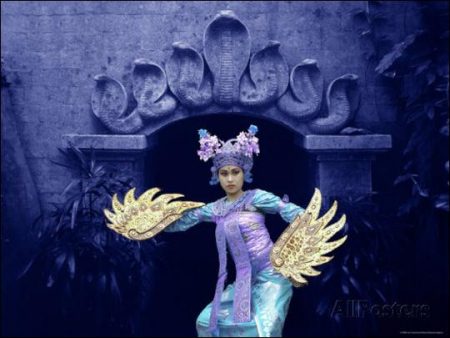Balinese dances is a very ancient dance tradition that is part of the religious and artistic expression among the Balinese people of Bali island, Indonesia. Balinese dance is dynamic, angular and intensely expressive. Balinese dancers express the stories of dance-drama through the bodily gestures including gestures of fingers, hands, head and eyes.
There is a great richness of dance forms and styles in Bali; and particularly notable are those ritualistic dance dramas which involve Rangda, the witch, and the great beast Barong. Most of dances in Bali are connected to Hindu rituals, such as the Sanghyang Dedari sacred dance than invoked hyang spirits that believed to possess the dancers in trance state during the performance. Other Balinese dances are not linked to religious rituals and created for certain purposes, such as Pendet welcoming dance and Joged dance that is social dance for entertainment purpose.
During the Intergovernmental Committee for the Safeguarding of the Intangible Cultural Heritage convention in 29 November to 4 December 2015 in Windhoek, Namibia, UNESCO recognizes three genres of traditional dance in Bali, Indonesia, as Intangible cultural heritage. The three genres includes Wali (sacred dances), Bebali (semi-sacred dances) and Balih-balihan (dances for entertainment purposes). The Balinese dance has been proposed since 2011,[3] and officially recognized in 2015.
The three genres are represented by nine dances, which describes its function and living tradition in Balinese community, they are:
Wali Sacred Dances
Rejang (Klungkung District). Sacred ceremonial dance by a young women in traditional ceremonial dress,
Sanghyang Dedari (Karangasem District). Sacred trance dance to counteract negative supernatural forces. Performed by two young girls.
Baris Upacara (Bangli District) religious dances conveying heroic spirit danced by even numbers of male dancers.
Bebali Semi sacred Dances
Topeng Sidhakarya/Topeng Pajegan (Tabanan District). Performed by masked dancers to neutralize the evil spirits.
Gambuh dance drama (Gianyar District). Formerly royal theatrical performance, now accompaniment to ceremonies, by 25-40 dancers.
Wayang Wong dance drama (Buleleng District). Combines dance, epic drama and music.
Balih-balihan Entertainment Dances
Legong Kraton (Denpasar City). Exquisitely beautiful dance by 2 or 3 girls. Developed from Sanghyang Dedari, and Gambuh.
Joged Bumbung (Jembrana District). A popular social dance by couples, during harvest season or on important days.
Barong Ket “Kuntisraya” (Badung District). Represents a fight between two mythological characters, Barong in the form of a lion symbolizing goodness and Rangda, an evil witch.
Visits: 119



